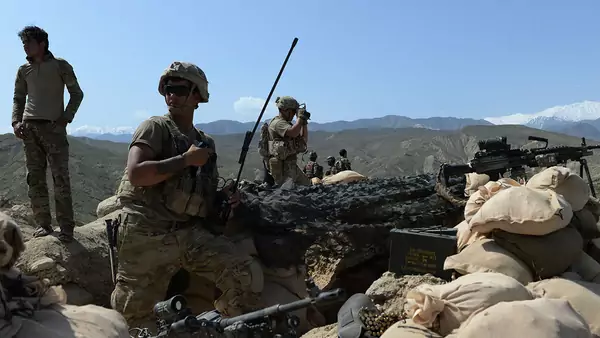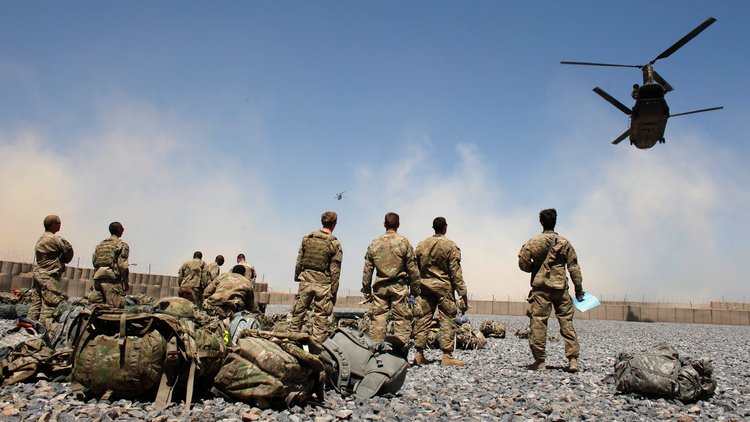by Lindsay Maizland
 After more than eighteen years of war in Afghanistan, the United States and the Taliban reached an agreement in what were both sides’ most intensive efforts yet to end the war. Central to the deal is a significant drawdown of U.S. troops and guarantees from the Taliban that the country will not become a safe haven for terrorists.
After more than eighteen years of war in Afghanistan, the United States and the Taliban reached an agreement in what were both sides’ most intensive efforts yet to end the war. Central to the deal is a significant drawdown of U.S. troops and guarantees from the Taliban that the country will not become a safe haven for terrorists.
However, experts stress that the deal between U.S. President Donald J. Trump’s administration and the Taliban leadership is only the first step to achieving lasting peace. The bigger challenge, they say, will be negotiating an agreement between the Islamist fundamentalist group and the Afghan government on Afghanistan’s future. Many Afghans, exhausted by a war that has killed thousands of people and forced millions to flee as refugees, fear that a U.S. withdrawal could spark new conflict and eventually allow the Taliban to regain control.
What did the United States and the Taliban agree to?
Following nine rounds of discussions, negotiators signed a peace agreement in February 2020 that addresses four main issues:
Cease-fire. Negotiators agreed to a temporary reduction in violence and said that a lasting cease-fire among U.S., Taliban, and Afghan forces will be part of intra-Afghan negotiations.
Withdrawal of foreign forces. The United States agreed to reduce its number of troops in the country from roughly 12,000 to 8,600 within 135 days. If the Taliban follows through on its commitments, all U.S. and other foreign troops will leave Afghanistan within fourteen months. Experts have cautioned that pulling troops out too quickly could be destabilizing.
Intra-Afghan negotiations. The Taliban agreed to start talks with the Afghan government in March 2020. Throughout the negotiating process, the Taliban had resisted direct talks with the government, calling it an American puppet. But the Taliban has more recently indicated that talks are possible, with deputy Taliban leader Sirajuddin Haqqani writing in a New York Times op-ed, “If we can reach an agreement with a foreign enemy, we must be able to resolve intra-Afghan disagreements through talks.”
Counterterrorism assurances. The United States invaded Afghanistan following the September 11, 2001, attacks largely to eliminate the threat of terrorism, so it seeks to halt terrorist activities in the country, including by al-Qaeda and the self-proclaimed Islamic State. As part of the agreement, the Taliban guaranteed that Afghanistan will not be used by any of its members, other individuals, or terrorist groups to threaten the security of the United States and its allies.
U.S. officials have also stressed protecting women’s rights. Prior to the 2001 overthrow of the Taliban, the group shuttered girls’ schools and prevented women from working, among other abuses. This issue could be discussed during intra-Afghan talks.
What are challenges to the peace process?
While the peace process is supported by a vast majority of Afghans, many issues remain to be worked out during intra-Afghan negotiations, including sharing power, disarming and reintegrating [PDF] Taliban fighters into society, and determining the future of the country’s democratic institutions and constitution. These negotiations were already off to a precarious start following the U.S.-Taliban deal in February. The United States and the Taliban agreed to the release of up to five thousand Taliban prisoners in exchange for up to one thousand Afghan security forces, but the Afghan government said it had not committed to such a swap.
The process could be complicated by a weak central government, afflicted by ethnic, sectarian, and tribal differences. The country’s 2019 election was marred by many problems: only 1.8 million out of 9 million registered voters cast ballots, polling stations were attacked, and results weren’t released for months. When incumbent President Ashraf Ghani was announced the winner, his challenger, Chief Executive Abdullah Abdullah, contested the results and said he would form his own government.
At the same time, experts say the Taliban is stronger now than at any point in the last eighteen years. With an estimated sixty thousand fighters, it controls many districts throughout the country and continues to launch major attacks, including in Kabul and on Afghan security bases. It earns millions of dollars from opium poppy cultivation [PDF] and the illegal drug trade, which pose further problems for the peace process. Some analysts are also worried that rank-and-file Taliban fighters might not abide by a peace deal.
Countries on Afghanistan’s borders, including Pakistan, which serves as the home base for the Taliban leadership, could feel excluded from talks and mobilize opposition against them. Additionally, the threat of terrorism is still present, with more than twenty terrorist groups operating inside the country, according to Afghan officials. Many of the groups are aligned with the Taliban or al-Qaeda, and the resurgence of the Islamic State is a concern.
Why are U.S. troops in Afghanistan?
The United States invaded Afghanistan in response to the 9/11 attacks, which were carried out by al-Qaeda. The Taliban, a predominantly Pashtun, Islamist fundamentalist group that had ruled Afghanistan since 1996, provided refuge to al-Qaeda and refused to hand over terrorist leader Osama bin Laden. At the start of the war, in October 2001, U.S. President George W. Bush said the U.S. mission was to “disrupt the use of Afghanistan as a terrorist base of operations and to attack the military capability of the Taliban regime.”
U.S.-led forces quickly ousted the Taliban, which retreated to Pakistan. From there, it has continued to wage an insurgency against the U.S.-backed government in Kabul, whose president was democratically elected in 2004. The United States and the North Atlantic Treaty Organization’s (NATO) mission then worked to bolster the Kabul government’s authority and reconstruct Afghanistan, in addition to fighting the Taliban insurgency.
In 2014, U.S.-led NATO forces ended their combat mission and passed on security responsibilities to the Afghan army and police. However, around seventeen thousand NATO troops, including U.S. service members, stayed in the country to train, advise, and assist Afghan security forces.
Timeline
The U.S. War in Afghanistan
1999–2020View Timeline

What’s been the toll of the war?
More than 157,000 people have died in the war [PDF] since 2001, according to researchers for the Costs of War Project at Brown University. More than 43,000 civilians have died, and by 2018 there were almost 2.5 million Afghan refugees worldwide, according to the UN refugee agency. More than 2,400 Americans have been killed and another 20,000 injured. Over 1,100 NATO troops have died. Analysts estimate that about 45,000 Afghan troops and police officers were killed in the past five years. Tens of thousands of Taliban fighters are believed to have been killed since 2001.
The war is estimated to have cost the United States around $2 trillion, including money spent on counternarcotics efforts, development projects, and support for Afghan security forces. Billions of dollars have been spent on medical and disability care for U.S. veterans.
What’s the role of other outside powers?
The U.S.-Taliban peace process has received wide support, including from NATO partners and from China and Russia.
Pakistan. The Taliban formed in Pakistan in the 1990s following the Soviet Union’s departure from Afghanistan. Many of its original fighters were Pashtuns who studied in Pakistani madrassas. After the U.S. invasion, Pakistan granted the Taliban safe havens and its Inter-Services Intelligence, which was thought to have some degree of control over the Taliban for years, provided military expertise and fundraising assistance. Experts say Pakistan now desires an Afghan government that includes the Taliban and is friendlier toward Islamabad than it is to New Delhi. (Officials in Islamabad have long feared Pakistani rival India gaining influence in Afghanistan). Pakistani Prime Minister Imran Khan has denied that the country has provided support to the Taliban and he has supported negotiations. Pakistani officials opened up a channel for U.S. negotiators to initially reach the Taliban.
India. New Delhi is a strong supporter of the Afghan government and has given $3 billion to develop infrastructure and cultivate business in Afghanistan since 2001. Its main goals are to minimize Pakistan’s influence and prevent Afghanistan from becoming a safe haven for anti-India militants. The Indian government did not back U.S. efforts to reach an agreement with the Taliban and disagreed with legitimizing the group as a political actor.
Iran. Shiite-majority Iran has long viewed the Taliban, a Sunni group, as a foe, especially since it has received support from Iranian rivals Pakistan, Saudi Arabia, and the United Arab Emirates. Iran accepted U.S. efforts to overthrow the Taliban in 2001 and supported the Afghan government. Iranian leaders have since acknowledged that the Taliban will continue to maintain some power in Afghanistan, so they have started working to improve ties. The trafficking of drugs from Afghanistan through Iran and opium addiction in Iran are problems in the two countries’ relationship.
Russia. Moscow hopes to rekindle ties with Afghanistan that were frayed when it withdrew from the country in 1989 following its decade-long occupation. Experts say Russia wants to take a lead role in the peace process and grow its influence in Afghanistan to counter the U.S. and NATO presence in the region. It has hosted several meetings between Taliban delegations and Afghan representatives in the past year.
China. Beijing’s interests in Afghanistan are primarily economic, as it hopes to integrate it into the Belt and Road Initiative, a collection of development and investment projects. China is the country’s largest source of foreign investment and it is interested in tapping into Afghanistan’s vast natural resources. Additionally, Beijing is concerned that terrorists could use Afghanistan to establish links within China. In late 2019, Afghan and Taliban officials attended a conference in Beijing, and Chinese leaders supported a U.S.-Taliban agreement.
International aid. Dozens of countries continue to provide assistance to Afghanistan, with 75 percent of the government’s public expenditures currently covered by grants from international partners, according to a World Bank report. The report warned that Afghanistan will continue to require billions of dollars in aid for years to come. Some experts believe that aid could be used as leverage to keep the Taliban in negotiations with the Afghan government.
No comments:
Post a Comment